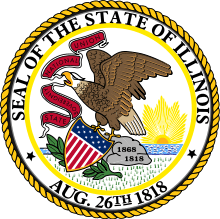Bradley, Illinois
| Bradley, Illinois | |
| Village | |
| Country | United States |
|---|---|
| State | Illinois |
| County | Kankakee |
| Elevation | 641 ft (195.4 m) |
| Coordinates | 41°08′47″N 87°51′33″W / 41.146332°N 87.859123°WCoordinates: 41°08′47″N 87°51′33″W / 41.146332°N 87.859123°W |
| Area | 7.24 sq mi (18.75 km2) |
| - land | 7.24 sq mi (19 km2) |
| - water | 0.00 sq mi (0 km2), 0% |
| Population | 15,070 (2009) |
| Density | 3,381.3/sq mi (1,305.5/km2) |
| Founded | 1891 |
| Mayor | Bruce Adams |
| Timezone | CST (UTC-6) |
| - summer (DST) | CDT (UTC-5) |
| Postal code | 60915 |
| Area code | 815/779 |
|
Location of Bradley within Illinois
| |
 Location of Illinois in the United States
| |
| Website: www | |
Bradley (formerly North Kankakee) is a village in Kankakee County, Illinois, United States. The population was 12,784 at the 2000 census, 15,070 in 2009, and 15,871 in 2012.
Bradley is a principal city of the Kankakee–Bradley Metropolitan Statistical Area, which includes all of Kankakee County. The county is also part of the larger Chicago–Naperville–Michigan City, IL-IN-WI Combined Statistical Area.
Geography
Bradley is located at 41°8′47″N 87°51′33″W / 41.14639°N 87.85917°W (41.146332, -87.859123).[1]
According to the 2010 census, Bradley has a total area of 7.24 square miles (18.75 km2), all land.[2]
History
In 1891, North Kankakee was established when the David Bradley Plow Works established a factory, and in recognition of this, in 1895, the town changed its name to Bradley City (later Bradley). Bradley was mostly a blue collar town with the Kroehler Furniture factory and the Roper Corporation factory (maker of kitchen ranges and ovens; part of their operations were in the building that David Bradley once occupied) being the major employers. In the 1980s, as with the rest of the Midwest, these factories closed, and after their closures, parts of those factories burned to the ground. However, by the end of the decade, things changed. In 1989, a new shopping center called Bradley Square was built with Wal-Mart as the first tenant, and more shops followed. The brightest spot in the village's history came on August 1, 1990, when Northfield Square Mall opened. Bradley was poised to attract business. Since that time, the village has been growing. Now, many businesses inhabit the area.
Demographics
| Historical population | |||
|---|---|---|---|
| Census | Pop. | %± | |
| 1900 | 1,518 | — | |
| 1910 | 1,942 | 27.9% | |
| 1920 | 2,128 | 9.6% | |
| 1930 | 3,048 | 43.2% | |
| 1940 | 3,689 | 21.0% | |
| 1950 | 5,699 | 54.5% | |
| 1960 | 8,082 | 41.8% | |
| 1970 | 9,881 | 22.3% | |
| 1980 | 11,015 | 11.5% | |
| 1990 | 10,792 | −2.0% | |
| 2000 | 12,784 | 18.5% | |
| 2010 | 15,895 | 24.3% | |
| Est. 2015 | 15,617 | [3] | −1.7% |
As of the census[5] of 2000, there were 12,784 people, 5,041 households, and 3,382 families residing in the village. The population density was 3,381.3 people per square mile (1,305.8/km²). There were 5,272 housing units at an average density of 1,394.4 per square mile (538.5/km²). The racial makeup of the village was 95.62% White, 1.23% African American, 0.21% Native American, 0.68% Asian, 0.02% Pacific Islander, 1.20% from other races, and 1.04% from two or more races. Hispanic or Latino of any race was 3.61% of the population.
There were 5,041 households out of which 33.5% had children under the age of 18 living with them, 51.3% were married couples living together, 11.0% had a female householder with no husband present, and 32.9% were non-families. 26.8% of all households were made up of individuals and 11.0% had someone living alone who was 65 years of age or older. The average household size was 2.49 and the average family size was 3.03.
In the village the population was spread out with 26.0% under the age of 18, 9.8% from 18 to 24, 31.5% from 25 to 44, 19.2% from 45 to 64, and 13.4% who were 65 years of age or older. The median age was 34 years. For every 100 females there were 94.3 males. For every 100 females age 18 and over, there were 90.7 males.
The median income for a household in the village was $41,757, and the median income for a family was $47,984. Males had a median income of $38,224 versus $24,493 for females. The per capita income for the village was $19,035. About 3.6% of families and 6.8% of the population were below the poverty line, including 8.2% of those under age 18 and 3.8% of that age 65 or over.
Places of local interest
References
- ↑ "US Gazetteer files: 2010, 2000, and 1990". United States Census Bureau. 2011-02-12. Retrieved 2011-04-23.
- ↑ "G001 - Geographic Identifiers - 2010 Census Summary File 1". United States Census Bureau. Retrieved 2015-08-02.
- ↑ "Annual Estimates of the Resident Population for Incorporated Places: April 1, 2010 to July 1, 2015". Retrieved July 2, 2016.
- ↑ "Census of Population and Housing". Census.gov. Archived from the original on May 11, 2015. Retrieved June 4, 2015.
- ↑ "American FactFinder". United States Census Bureau. Archived from the original on 2013-09-11. Retrieved 2008-01-31.

